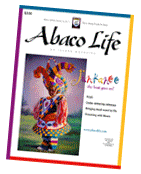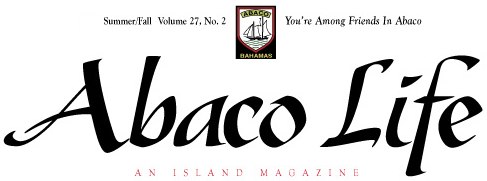Archive for July, 2003
Little Harbour
--------------------------------------------------
By Jim Kerr
"I have been told of a place that sounds like the paradise we have been looking for," wrote Randolph Johnston in his diary. "It is called Little Harbour, and is in the Abaco area."
The date of the entry, written by the man who would become an Abaco legend and its most renowned sculptor, was May 30, 1952. Two days later Johnston, his wife Margot, their daughter Marina, and three sons, Bill, Pete and Denny, stepped ashore at Little Harbour for the first time, alighting from the Johnston's sailing schooner Langosta. For the former teacher turned island pioneer, a man who longed for a tranquil life away from the industrial "megamachine" and the influences of materialism, this was the ultimate fantasy.
"It is beautiful beyond description," he wrote. "In this landlocked haven there is a perfect semicircle of white beach gently lapped by water so clear you can not tell where dry sand stops and water begins. A high rock-ribbed dune shelters us from from the trade winds 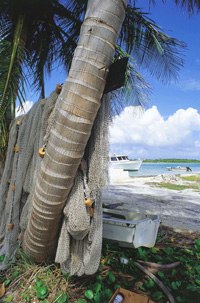 and the now invisible surf of the ocean we have just crossed. There is no sign of man except the distant roof of the Little Harbour Light."
and the now invisible surf of the ocean we have just crossed. There is no sign of man except the distant roof of the Little Harbour Light."
Coconut palms, sheltered by the dune on the ocean side, lined the east rim of the harbour, while to the west were "high, verdant cliffs, pierced by numerous caves." It was in one of them, a yawning recess measuring 50 feet wide and 10 feet high, that the Johnstons first took up residence. Bats and owls swirled about gothic columns of stalagmites. Crabs the size of grapefruit skittered about, and dark lichen shapes on the walls gave the whole place a gothic and macabre appearance. It gave Margot the creeps, but the kids loved it.
Today the cave is almost a shrine at Little Harbour; a symbol of resilience where one family's determination and self-reliance built and maintained what now amounts to a residential colony anchored by a foundry, gallery and an open-air beachfront watering hole known as "Pete's Pub." Its namesake is Pete Johnston, Rand's middle son, who at age 60 is the second generation reigning patriach of Little Harbour. A stocky, barrel chested man with a distinctive dark mustache, Pete is almost as recognizable in Abaco as his work, which ranges from bronze belt buckles to elaborate tables featuring sculpted sea life under glass. Today he is assisted by a cadre of talent which includes his two sons, Greg and Tyler, and Richard Appaldo, who studied under Randolph in the early 1980s and came back to live permanently almost 10 years ago.
Randolph Johnston's bronze art foundry at Little Harbour flourished. His sculptures became famous and ultimately lucrative. One of his large works, titled "St. Peter: Fisher of Men," rests in the Vatican's museum in Rome. He suffered a debilitating stroke in 1989 and died three years later at age 89. Margot died in 1998, also at age 89. They lived long and fruitful lives, and despite disappointing calamities and setbacks, their resolve always brought them back from adversity, a characteristic inherited by Pete. His home at Little Harbour, along with the original Pete's Pub, was destroyed by fire in 1986. His first wife, Debbie, died of cancer in the early 1990s, and in 1999 Hurricane Floyd virtually wiped out Little Harbour.
"Floyd totaled everything," says Pete. "The foundry was 80 percent lost, as were 50 percent of the gallery contents. The pub was totaled. Nothing was insured and we're still recovering, although we've been casting for three years since the storm. But we were out of business for 14 months." Loses were estimated at half a million dollars.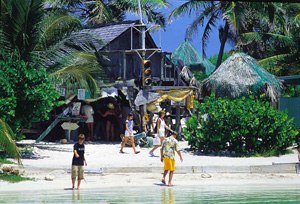
Clients helped the cash flow by paying in advance for sculptures, including 40 special edition sculptures of Man-O-War boat builders, a "symbolic rebuilding" piece.
Today the foundry, gallery, Pete's home and the pub have all been rebuilt. The Little Harbour team effort is rounded out by Greg's fiancee, Heather, who works in the gallery and manages the books and marketing chores, and about eight staff members who run Pete's Pub. The original was constructed in 1968 from the pilot house of the old Langosta. Today's version, while still retaining its out island ambience, is supported by a new modern kitchen and plumbing. "It's not a topless bar," jokes Pete, noting the pub has a roof. "It's more of a sideless saloon."
People complained when it rained, he says. And the outdoor "his and hers" palm trees have been replaced by indoor restrooms. Picnic tables and benches are scattered beneath protective palm trees. The bar and picnic area is floorless. The soft sand, cool and relaxing on bare feet under the shaded tables, turns significantly warmer climbing from the pub to the crest of the hill to the east. Beyond the dune is the blue Atlantic crashing ashore, and beyond that there is nothing but horizon.
Humour has always been a trademark for Pete Johnston. So has his affinity for the environment and wildlife. Dolphins, turtles and stingrays which inhabit Little Harbour's waters have been immortalized in hundreds of sculpures, ranging from three-inch high seahorses to 40-pound table-top pieces. Among the latter, there are currently three in a series, each one depicting a stage in Hemingway's classic novel "The Old Man and the Sea." In the first, the old man is seen catching the marlin. In the second, he unsucessfully fends off the attacking shark, and in the third he sails home with the pitiful remains. The variously sized works in the gallery also range in price accordingly, from about $20 up to $10,000. Personalized custom work is also popular, such as coffee tables with assorted marine life.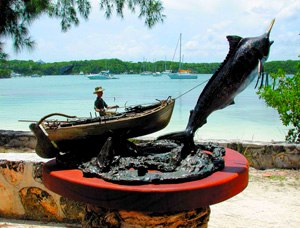
The Johnston dynasty at Little Harbour, from its cave-dwelling early days to its successful establishment as a community and business, is chronicled in "Artist on His Island: A Study in Self Reliance." First published in 1975 with assistance from Denny Johnston, the book is based on Ran's log dating from January 17, 1951 when he first came to the Bahamas, to December, 1974. Denny notes that "Little Harbour has changed greatly since that day when we first sailed in so many years ago." A few cottages have sprung up, he says in his "summing up" at the conclusion of the book, due to Ran's sale of property to holiday residents. A second edition was published in 2000, with an update from brother Bill, who also lives part time at Little Harbour with his wife, Judy. He also observes dramatic changes at Little Harbour, but this time, a quarter of a century after the book's first edition, it is largely his own resolve and resources which have fostered it. After the disasterous 1986 fire, Bill bulldozed a rough road from Little Harbour to what was then a rough gravel road leading into the tiny community of Cherokee. And when the Cherokee road was paved in the 90s, connecting it with the new Abaco Highway and Marsh Harbour, Little Harbour was no longer isolated. Several large generators installed by Bill now supply electricity, and there is telephone service.
On any given afternoon, and particularly on weekends, rental cars and motor scooters fill up the little sandy parking area south of Pete's Pub. Marsh Harbour is now only 20 miles and 45 minutes or so away over good, if somewhat winding, roads. Only the last four miles from the Cherokee Road to Little Harbour is unpaved. The harbour is filled with moored and anchored power and sailboats, and a dozen rental boats are often tied up at the docks. Pete estimates 25,000 visitors a year come to Little Harbour, 80 percent of them by boat. But even though some have lamented the changes here, Little Harbour is still delightfully remote, far from the "megamachine" that Ran Johnston sought so hard to escape. Turtles, stingrays and dolphins inhabit the water, and a fringe reef along the east shore at the mouth of the harbour offers excellent snorkeling. Families with kids frolic in the shallow, protected water off the harbour shore, and the pub, open for lunch and dinner, is filled with patrons. A wild boar roast is held on Saturdays. Directly northwest is Robinson Bight, with its blue holes and bonefishing along the flats, and Pelican Cays Land and Sea Park is minutes away by boat.
The gallery, housed in a solid, hopefully hurricane-proof concrete building, contains a wide variety of artwork, from jewelry to large and small sculptures. The gallery contents are dominated by bronze sealife, but some original works by Ran Johnston are also archived here in a museum setting. His "Nine Ages of Man," an arch representing the cycle of life, ascended and descended by man at various ages of life, is displayed. Fifty special edition replicas of the work, which will be one-half the original size, are being planned, with a sale price of $10,000 apiece. Greg Johnston's series of bronze bonefish eating a silver crawfish, sea horses and other small pieces are also on display, along with the "Old Man and the Sea" series, dolphins, turtles and other marine life, some of it encased in furniture.
All of it comes from an elaborate foundry on the premises. The process used is called the lost wax bronze casting method, a practice that goes back 5,000 years. A wax model is encased in a heat-resistant material such as clay or plaster. The product is heated so that the mold hardens and the wax melts. The remaining cavity, a negative image of the model, is then filled with molten metal. The surrounding cover is removed after it cools, revealing a solid metal object in the image of the original model. The artwork can then be polished or painted. It's a complex and sometimes dangerous process, involving molten metal and several stages, each with ample room for error. A guided trip around the foundry, which can only be arranged when work is not in progress, is impressive. The gallery is supervised by Richard Appaldo, Ran Johnston's last student in 1983. He helped his mentor with the statue of Sir Milo Butler, which is displayed in Nassau, and with the St. Peter sculpture now in the Vatican. Appaldo stayed here for three years, then visited annually before returning to reside at Little Harbour permanently in 1993.
About 40 homes have been built at Little Harbour since Randolph Johnston sailed in, moved out of a cave and into a house himself. Before that, the only stucture was a small lighthouse, and the only inhabitants its keeper and his family (see sidebar). The remains of the lighthouse, its roof finally blown off by Floyd, can be reached via a path which starts from the shoreline and winds up the hill through seagrapes and bush. The view is the same as it was half a century ago, and beyond. Few people venture up here these days. Most are content to swim in the harbour, tour the gallery and settle into the pub. But it is up here, where the ocean meets the craggy rocks below, and the green Abaco coastline stretches away, that one understands how truly wild and remote life once was at Little Harbour.

